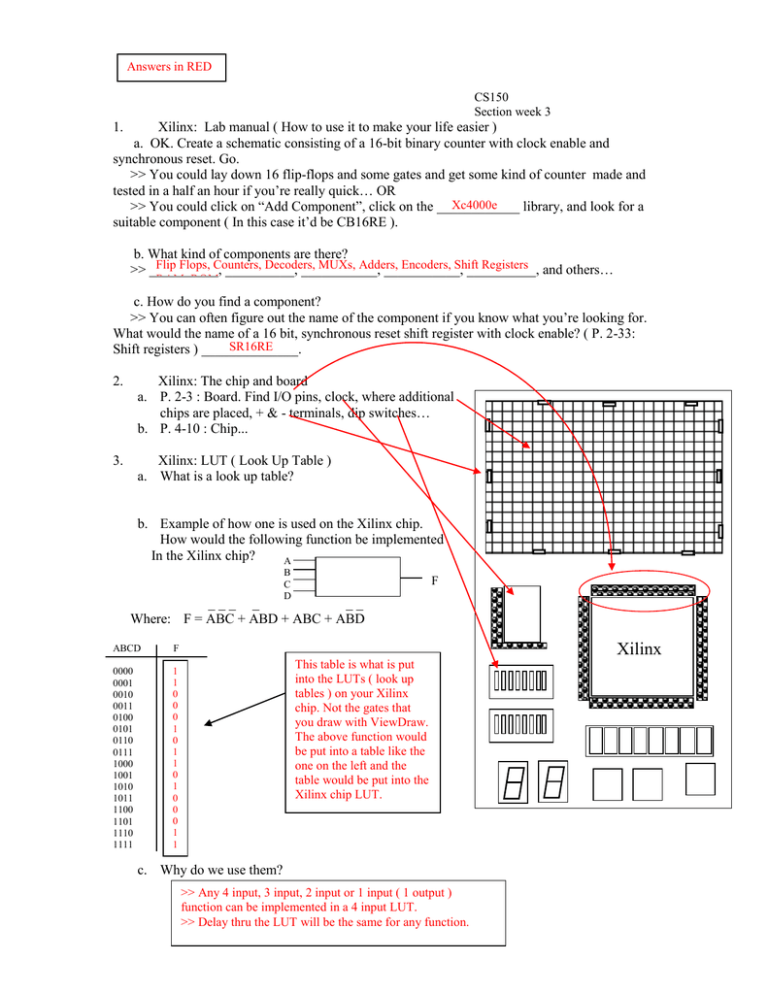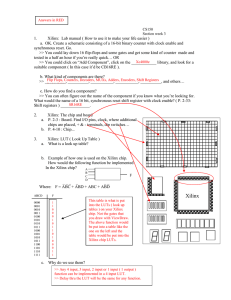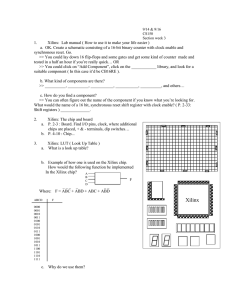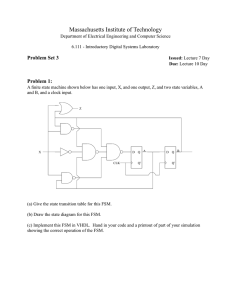Week 3 ( 9/13 & 9/15 ) ( In Word!!!!! )
advertisement

Answers in RED CS150 Section week 3 1. Xilinx: Lab manual ( How to use it to make your life easier ) a. OK. Create a schematic consisting of a 16-bit binary counter with clock enable and synchronous reset. Go. >> You could lay down 16 flip-flops and some gates and get some kind of counter made and tested in a half an hour if you’re really quick… OR Xc4000e >> You could click on “Add Component”, click on the ____________ library, and look for a suitable component ( In this case it’d be CB16RE ). b. What kind of components are there? Flip Flops, Counters, Decoders, MUXs, Adders, Encoders, Shift Registers and others… >> __________, __________, ___________, ___________, __________, RAM, ROM c. How do you find a component? >> You can often figure out the name of the component if you know what you’re looking for. What would the name of a 16 bit, synchronous reset shift register with clock enable? ( P. 2-33: SR16RE Shift registers ) ______________. 2. Xilinx: The chip and board a. P. 2-3 : Board. Find I/O pins, clock, where additional chips are placed, + & - terminals, dip switches… b. P. 4-10 : Chip... 3. Xilinx: LUT ( Look Up Table ) a. What is a look up table? b. Example of how one is used on the Xilinx chip. How would the following function be implemented In the Xilinx chip? A B C D F ___ _ __ Where: F = ABC + ABD + ABC + ABD ABCD 0000 0001 0010 0011 0100 0101 0110 0111 1000 1001 1010 1011 1100 1101 1110 1111 Xilinx F This table is what is put into the LUTs ( look up tables ) on your Xilinx chip. Not the gates that you draw with ViewDraw. The above function would be put into a table like the one on the left and the table would be put into the Xilinx chip LUT. 1 1 0 0 0 1 0 1 1 0 1 0 0 0 1 1 c. Why do we use them? >> Any 4 input, 3 input, 2 input or 1 input ( 1 output ) function can be implemented in a 4 input LUT. >> Delay thru the LUT will be the same for any function. 4. FSMs: Using a decoder for implementing logic… ( Kinda like a LUT… ) a. What’s a 3:8 decoder? ABC 000 001 010 011 100 101 110 111 01234567 10000000 01000000 00100000 00010000 00001000 00000100 00000010 00000001 0 1 2 3 4 5 6 7 A B C c. Use an 3:8 decoder and a single gate ( you can use bubbles ) to implement the following circuit’s output and NSD. ( Note: This circuit uses a 4 state FSM. ) IN 0 0 0 0 1 1 1 1 PS0 PS1 OUT NS1 NS0 0 0 0 1 0 0 1 1 1 1 1 0 1 1 0 1 1 0 0 0 0 0 0 1 0 0 1 0 1 0 1 0 0 0 1 1 1 1 1 0 0 1 2 3 4 5 6 7 IN PS0 PS1 Something to think about… Which of these ( OUT, NS1, NS0 ) is following the sum of products pattern? Which is following the product of sums pattern? NS1 OUT NS0 5. Serial to parallel converter ( Based on F97 HW #3, problem #3 ) Design a system which can convert 4 serial input bits ( SerialData ) to an 4 bit parallel output. In the final circuit you should use a 4 bit shift register and a 2 bit counter from the Xilinx library and any other necessary logic. The serial data comes in MSB first. Circuit timing is described in the timing diagram below. Solution: Step 1: Identify Inputs and Outputs GIVEN: SerialData Start Clk Step 2: Timing Diagram GIVEN: CLK Done ? ? Bit3 Bit2 Counter ? ? 0 1 DataOut0 DataOut1 DataOut2 DataOut3 ?0 ?1 ?2 ?3 ?0 ?1 ?2 ?3 ?0 ?1 ?2 ?3 SD3 ?0 ?1 ?2 Wait ? Wait ? Shift Run Shift Run SerialData Bit1 Bit0 ? ? ? 2 3 0 1 SD2 SD3 ?0 ?1 SD1 SD2 SD3 ?0 SD0 SD1 SD2 SD3 SD0 SD1 SD2 SD3 Shift Full Wait Run Wait Run DataOut[3:0] 4 Start Done FSM1 State FSM2 State Shift Run Step3: Decide whether to make it a Mealy or a Moore… Let’s make this a Moore. Step 4: State Transiton Diagram Two possibilities: Possibility 1: START Shift 1 DONE Wait 0 DONE E ______ START Shift 3 DONE Shift 2 DONE Shift 4 DONE Possibilty 2: We’re doing the same thing in 4 separate states ( 4 x Shift State ) in the above STD. Let’s, instead, make one state that does what the shift states above do and stay in it for 4 cycles. We’ll need a signal that’ll tell us when 4 clock cycles have gone by. To make this signal let’s make a separate FSM that counts to 4 and outputs a high signal when it’s counted to 4. START FSM1: ______ START FSM2: Wait 0 DONE Shift 1 DONE ________ COUNT4 The rest of the problem uses this design. COUNT4 START Count 0 COUNT4 Count 1 COUNT4 Count 2 COUNT4 Count 3 COUNT4 Step 5: State Transition Tables ( Working with “Possibility 2” ): Let’s do FSM 2 first: Skipping numerous steps, I see that it looks like a counter that counts to 4, and that there’s a component in the Xc4000e library that does exactly that: CB2RE. Attaching the Start signal to the RESET input of the counter sets the counter to zero when the START goes high. The TC output goes high when the counter has reached it’s maximum value, 3, which is when we want COUNT4 to go high… So, ignoring inputs and outputs that we don’t use the second FSM is just: CB2RE START This is the complete implementation of FSM 2. CLK RESET TC COUNT4 FSM 1: To design FSM 1 you need to go thru all the steps. STT: START 0 1 X X INPUTS PS COUNT4 0 X 0 X 1 0 1 1 OUTPUTS DONE NS 1 0 1 1 0 1 0 0 Step 6: Equations: __ DONE = PS __ ________ NS = START PS + COUNT4 PS Step 7: Circuit: Entire Circuit START NS STATE NS = __ START PS + ________ COUNT4 PS OD FDR NS DONE __ DONE = PS PS GND R CLK FSM 1 CB2RE VCC FSM 2 START ENABLE RESET TC CLK COUNT4 CONTROLLER SR4RE DATAPATH SerialIn GND PS CLK R ENABL E DataOut[3:0]




